
- Magazine Première Édition
- Genre
- Action & Adventure (20)
- Actualités (12)
- Art & Photographie (30)
- Art & Photography (65)
- Art Et Photographie (12)
- Celebrity (18)
- Comics (12)
- Fashion (26)
- Histoire (39)
- History (49)
- Hommes (24)
- Horreur & Monstre (16)
- Horror & Monster (24)
- Jeux Vidéo (18)
- Manga & Anime (14)
- Men (33)
- Mode (22)
- Music (20)
- Sports (36)
- Video Games (40)
- Autre (3363)
- Langue
- Pays D'origine
- Signé
- Sujet
- Actualités (8)
- Americana (11)
- Art (23)
- Art & Photographie (7)
- Automobile (8)
- Bandes Dessinées (11)
- Gay (8)
- Guerre (6)
- Histoire (11)
- Historique (15)
- Illustré (8)
- Intérêt Masculin (8)
- Littérature (7)
- Livres (9)
- Manga (10)
- Mode (30)
- Modélisation (16)
- Photographie (18)
- Politique (16)
- Électronique (7)
- Autre (3656)
- Éditeur
- American Media Inc (23)
- Andy Worhol (3)
- Condé Nast (32)
- George Newnes (5)
- Harper & Brothers (8)
- Harpers Magazine (4)
- Hmh (5)
- Hmh Publishing (8)
- Hmh Publishing Co. (6)
- Kodansha (4)
- Moses Thomas (4)
- Nintendo (9)
- Nintendo Of America (8)
- Nintendo Power (6)
- Parliament (4)
- Playboy (12)
- Slam (4)
- Time (7)
- Time Inc. (5)
- Time, Inc. (5)
- Autre (3731)
Gravure en couleur rare de 1814 de Curtis Botanical Folio No. 1671 RHODODENDRON CATAWBA
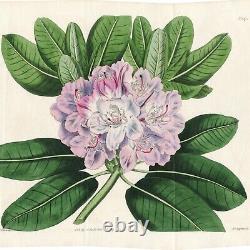

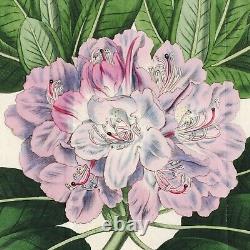
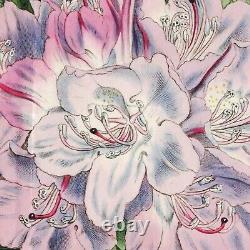

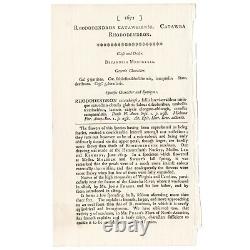
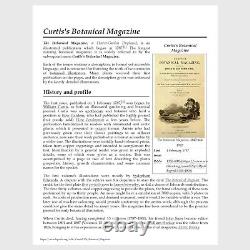


Rare 1814 Hand-Colored Copperplate Engraving from. The Botanical Magazine or Flower-Garden Displayed'. From early volumes of "The Botanical Magazine; or Flower-Garden Displayed" comes this original, Double, fold-out folio copperplate engraving, a rare & sought-after large-format plate from the scarce early volumes. This listing is for the one print from the above work: No. It's my 2nd, & last copy of this lavish plate, the first one was acquired.
From a quick search, this one has apparently become very rare indeed. I've been listing a superb collection of these very scarce folio, fold-out, largest hand-colored engravings from this most important publication documenting the discovery of these flowers. The Double-sized fold-out plates were reserved for the showiest, most dramatic, largest flowers.
They were very rare in the series, & yet much more rare in the market, as they can often make the most impressive framed wall-art in terms of scale & image & are sought-after if & when one can be found. This plate is one of the classics of the Curtis volumes. This one is likely a First Edition print, which are generally very rare. Appears to be on the original wove paper, which came to be used in the early years of the 1800's.After the death of William Curtis, the magazine was published by his brother, Thomas Curtis. Later, Samuel Curtis (a son-in-law of William Curtis) became proprietor from 1801 to 1845. The prints in the first volumes were copper plates colored by hand. Some of the later prints were lithographs.
Some of the distinguished artists were Sydenham Edwards, John Curtis, William Jackson Hooker, W. Fitch, William Graves and Matilda Smith.
These prints have a universal beauty and are a lasting documentary contribution to botanical studies. The Artists: This one is signed for both the publisher S. The drawing & coloring are quite stunning.
It's a beautiful plate, full of the passion that the early flower painters, botanists & gardeners had for these amazing flowers, many of which were discovered in the pristine reaches of the ever-expanding British Empire & by intrepid explorers of the time. These gorgeously drawn, engraved & water-colored original prints were presented on their page with consistently balanced, beautiful compositions. Every part of these prints was made by hand: Hand drawn & engraved on Copper which was hand-mined, smelted & rolled, printed onto handmade cotton rag paper, inked & colored with hand-ground pigments individually by hand, & they were usually hand sewn into handmade leather-bound books. Condition: Appears to be in excellent condition. The hand-coloring remains sharp & brilliant.
The folds in this one are as-issued & appear in all copies I've seen of this plate as it's a'fold-out' & much larger than the rest which were octavo-sized bookplates. Trimmed a bit irregularly as sometimes happened with fold-outs (seemed they trimmed them after they were folded during binding of the volume), without effecting image. Plate-mark is intact on all sides with lots of margin, it should matt nicely, or floated. These prints are very old & may have minor imperfections expected with age, such as some typical age-toning of the paper, oxidation of the old original watercolors, spots, text-offsetting, artifacts from having been bound into a book, etc. Please examine the photos & details carefully.
Text Page(s): This one comes with its original text pages. Rhododendron catawbiense, with common names Catawba rosebay, Catawba rhododendron, mountain rosebay, purple ivy, purple laurel, purple rhododendron, red laurel, rosebay, rosebay laurel, is a species of Rhododendron native to the eastern United States, growing mainly in the southern Appalachian Mountains from Virginia south to northern Alabama. It is a dense, suckering shrub growing to 3 m tall, rarely 5 m. The leaves are evergreen, 6-12 cm long and 2-4 cm broad.
The flowers are 3-4.5 cm diameter, violet-purple, often with small spots or streaks. The fruit is a dry capsule 15-20 mm long, containing numerous small seeds. Rhododendron catawbiense is cultivated as an ornamental plant, popular both in North America and in parts of Europe. It is primarily grown for its spring flower display. Outside of its native range, many cultivars and hybrids have been created, [6] such as'Purple Elegans','Roseus Elegans', and'Grandiflorum.
Size: 9 x 12 inches approximately. If you'd like to combine & need more time to choose, please send a message & we'll do our best to oblige.

